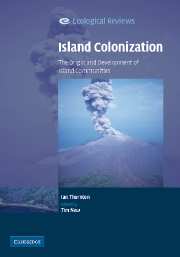Book contents
- Frontmatter
- Contents
- Editorial preface
- Acknowledgements
- PART I Theoretical and experimental studies
- PART II Natural recolonization after devastation
- PART III The recolonization of devastated islands
- 5 Recovering island biotas: Volcano and Bárcena
- 6 Thera, Santorini Group, Mediterranean
- 7 Long and Ritter Islands, Bismarck Sea
- 8 Krakatau, Sunda Strait
- PART IV Assembly of biotas on new islands
- PART V Colonization and assembly
- References
- Index
6 - Thera, Santorini Group, Mediterranean
Published online by Cambridge University Press: 12 January 2010
- Frontmatter
- Contents
- Editorial preface
- Acknowledgements
- PART I Theoretical and experimental studies
- PART II Natural recolonization after devastation
- PART III The recolonization of devastated islands
- 5 Recovering island biotas: Volcano and Bárcena
- 6 Thera, Santorini Group, Mediterranean
- 7 Long and Ritter Islands, Bismarck Sea
- 8 Krakatau, Sunda Strait
- PART IV Assembly of biotas on new islands
- PART V Colonization and assembly
- References
- Index
Summary
One of the oldest known cases of the recovery of an island's ecosystem from devastation is that of a volcanic island in the Aegean Sea, between Greece, Turkey and Crete in the eastern Mediterranean (Fig. 6.1).
Around 1620 BC, the island of Thera, in the small Santorini Archipelago of the Cyclades group, about 70 km north of Crete, erupted catastrophically. This eruption was not only very large and powerful by volcanic standards but also was probably one of the most influential eruptions in human history (perhaps after that of Ancient Krakatau in AD 475). It was an event of huge proportions that occurred in what was then a relatively small, developing, Western world, and thus took on a social, political and historical significance far transcending what even an eruption of this magnitude might have today. One view is that the decline of the Minoan civilization on Crete in the seventeenth century BC stemmed from the psycho-sociological effects of this eruption (known as the Minoan eruption), and there can be little doubt that, if not directly responsible, at the very least the eruption played an important role in the decline of that culture (de Boer and Sanders 2002).
In legend, the island is referred to as Stronghyli (round island) and was called Kalliste (most fair, best) by the Phoenicians, one of the first peoples to colonize it.
- Type
- Chapter
- Information
- Island ColonizationThe Origin and Development of Island Communities, pp. 72 - 94Publisher: Cambridge University PressPrint publication year: 2007



